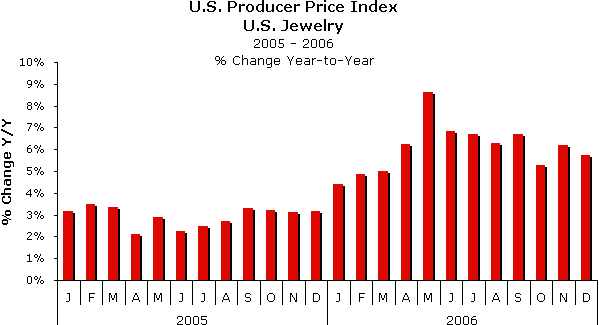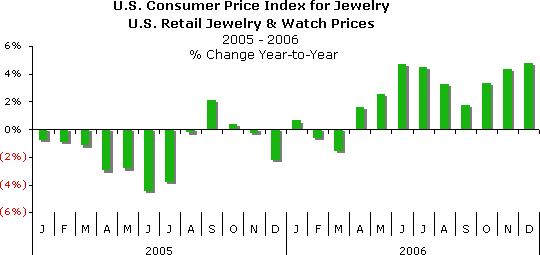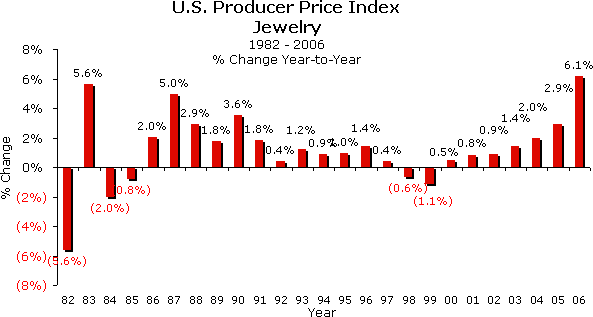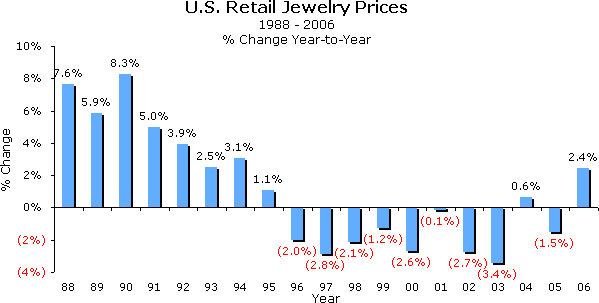IDEX Online Research: Jewelry Price Inflation Rises in U.S.
January 23, 07
Jewelry price inflation continued to surge in December, both at the producer level and at the consumer (retail) level. After cooling earlier in the fall, the flames of inflation flared higher in the final months of 2006.
Retailers continued to raise prices in the face of higher producer costs, even though they risked alienating consumers with high prices just as the industry headed into the all-important holiday selling season of November and December 2006.
Despite the price increases at retail, most of the major publicly held companies reported gross margin erosion in the holiday period, largely brought on by higher commodity costs. In short, retailers were unable to pass on jewelry producers’ higher prices.
For 2007, IDEX Online Research is predicting that retail prices of jewelry in the U.S. will rise by at least 3 percent, somewhat ahead of the 2.4 percent rise (preliminary) for 2006. The 2007 price increases will be driven by pass-throughs of higher producer prices. However, we are forecasting nearly flat unit sales of jewelry in 2007.
Jewelry Producer Prices Up
Jewelry producer prices rose by 5.7 percent in December 2006 versus December 2005, far above inflation trends in recent years, but in line with producer price increases during 2006.
The graph below summarizes the Producer Price Index for jewelry in the U.S. market during 2005 and 2006.

Source: BLS
Jewelry producer prices in the U.S. rose sharply, in concert with virtually all categories of producer prices in December. Food and energy prices pushed up the U.S. producer price index for all commodities. Excluding food and energy, however, core producer price inflation was a tamer +2 percent at an annual rate, quite in line with most economists’ definition of “modest” inflation.
Overall producer price inflation in December does little to change the inflation picture in the U.S. Despite inflationary December numbers, the trend is toward more moderate inflation heading into 2007, though some pipeline pressure remains, especially at the intermediate level.
Retail Jewelry Prices Up In December
Retail prices in December surged to their highest level of 2006 – up 4.8 percent for the month. In fact, the last time prices surged this strongly in any month of the year was 1994. It is unusual for jewelry prices to rise sharply in December, since this is the most important month of the year for retail jewelers. Typically, jewelers hold prices steady in December, hoping to increase sales while holding margins; this year, however, jewelers were forced to raise their retail prices in an effort to try to maintain margins.
The graph below summarizes the Jewelry Consumer Price Index by month for 2005 and 2006.

Source: BLS
Jewelry prices in December ran counter to inflation trends for other commodities. In general, retail prices stabilized in December according to the Bureau of Labor Statistics. Large swings in energy prices masked trends for core inflation which reflected a mild deceleration.
Jewelry Producer Prices Post Record Increase in 2006
Jewelry producer prices in the U.S. surged by 6.1 percent increase, the largest increase on record since the BLS began keeping PPI statistics in the early 1980s on the current basis. Most of the producer price increase was driven by higher precious metals costs, including surging prices of gold, silver, and platinum. In addition, higher diamond prices, especially in 2005, helped push producer prices higher.
The graph below illustrates the Jewelry Producer Price Index on an annual basis from 1982 through 2006.

Source: BLS
Retail Jewelry Prices Rise Sharply in 2006
In the past decade, retail jewelry prices have fallen in eight out of ten years. In 2006, retail jewelry prices in the U.S. rose by 2.4 percent. However, because retail jewelry prices rose unexpectedly in December, it is clear that producer price increases – up 6.1 percent for the year – are flowing through to retailers who were forced to raise their retail prices in an effort to preserve their margins. Unfortunately, the 2.4 percent annual increase in jewelry retail prices was not enough for most retail jewelers, since the major publicly held companies – Tiffany, Zale, and Sterling – reported that their gross margins were down in the holiday selling period of November-December 2006.
The graph below summarizes jewelry prices at the retail level for the U.S. market since 1986, when the BLS began keeping CPI statistics on the current base.
 Source: BLS |
Retail Jewelry Prices Likely to Rise in 2007
IDEX Online Research is forecasting higher retail prices for jewelry in 2007. Sharp increases in producer prices in 2006 still have not been reflected in retail prices. Further, labor and commodity costs appear to be headed higher in 2007.
While it appears that jewelry sales in 2006 were up nearly 7 percent for the year, based on preliminary eleven-month figures, at least a third or more of that increase is due to higher prices. Core unit sales of jewelry rose by just over 4 percent in 2006, based on reported jewelry price inflation rates.
In 2007, IDEX Online Research is forecasting that U.S. jewelry sales – as measured by “dollars through the cash till – will rise by 3 to 4 percent for the year. Based on our preliminary jewelry price inflation forecast of 3 percent or more, this means that unit sales of jewelry in 2007 are likely to be nearly flat.